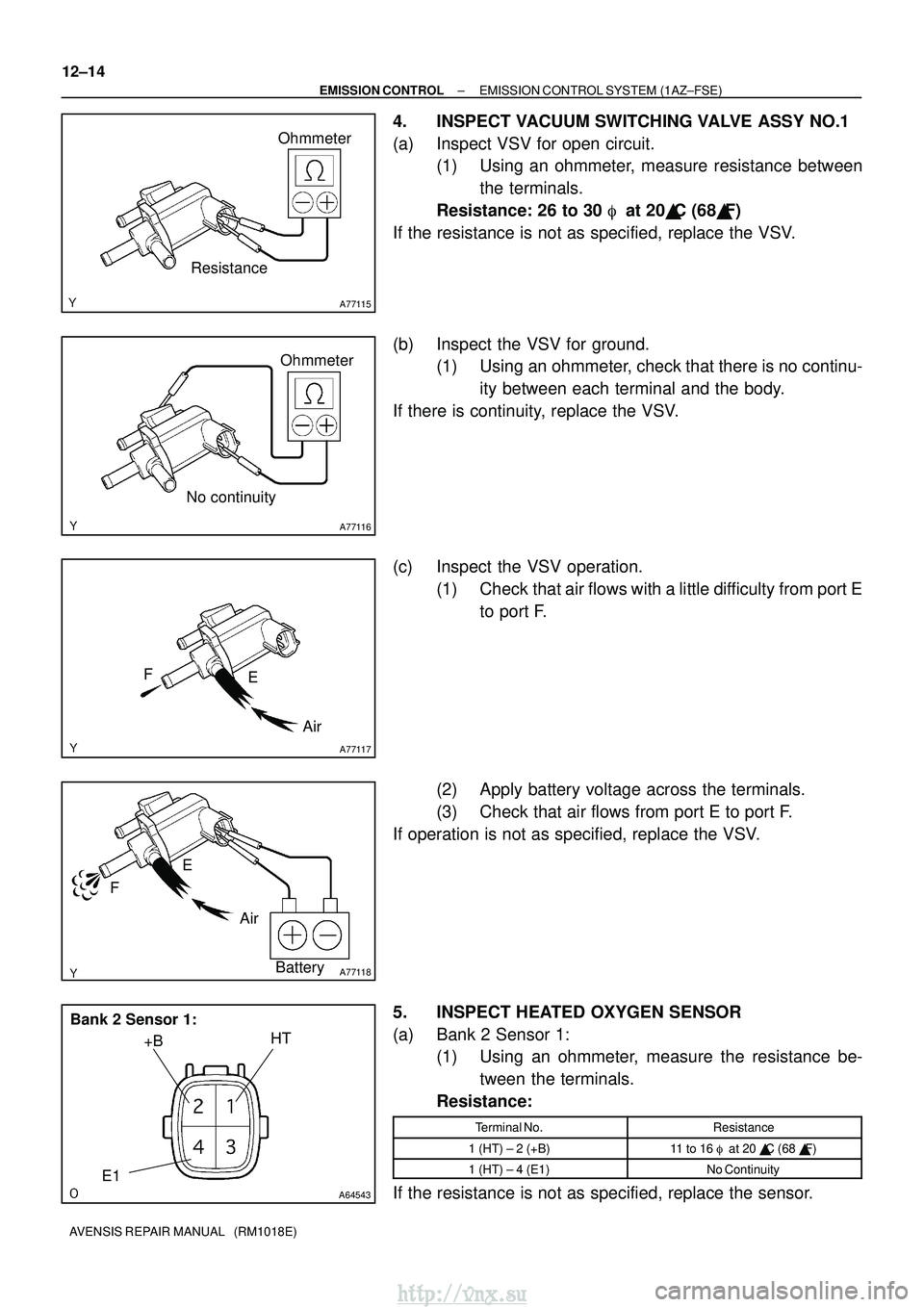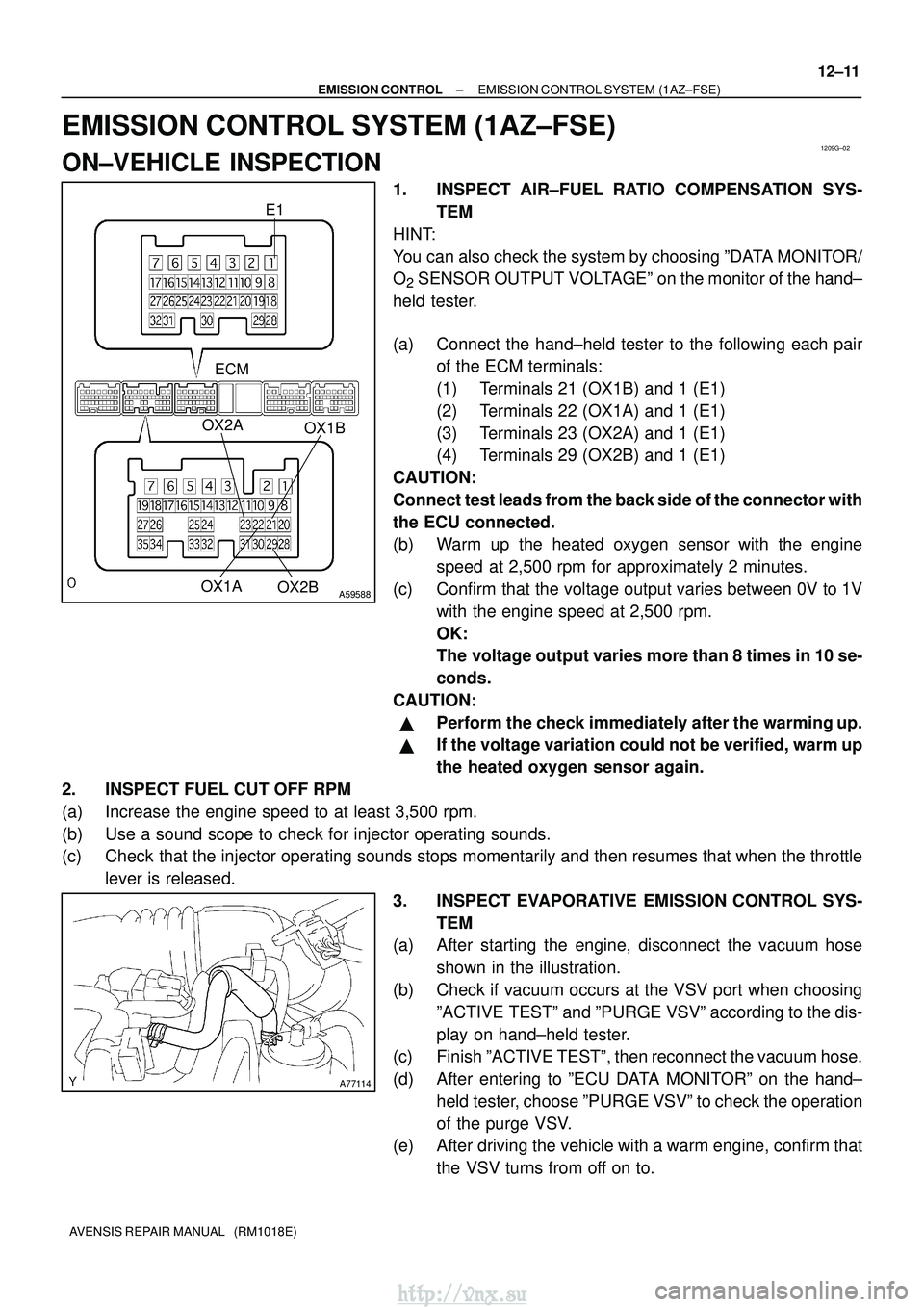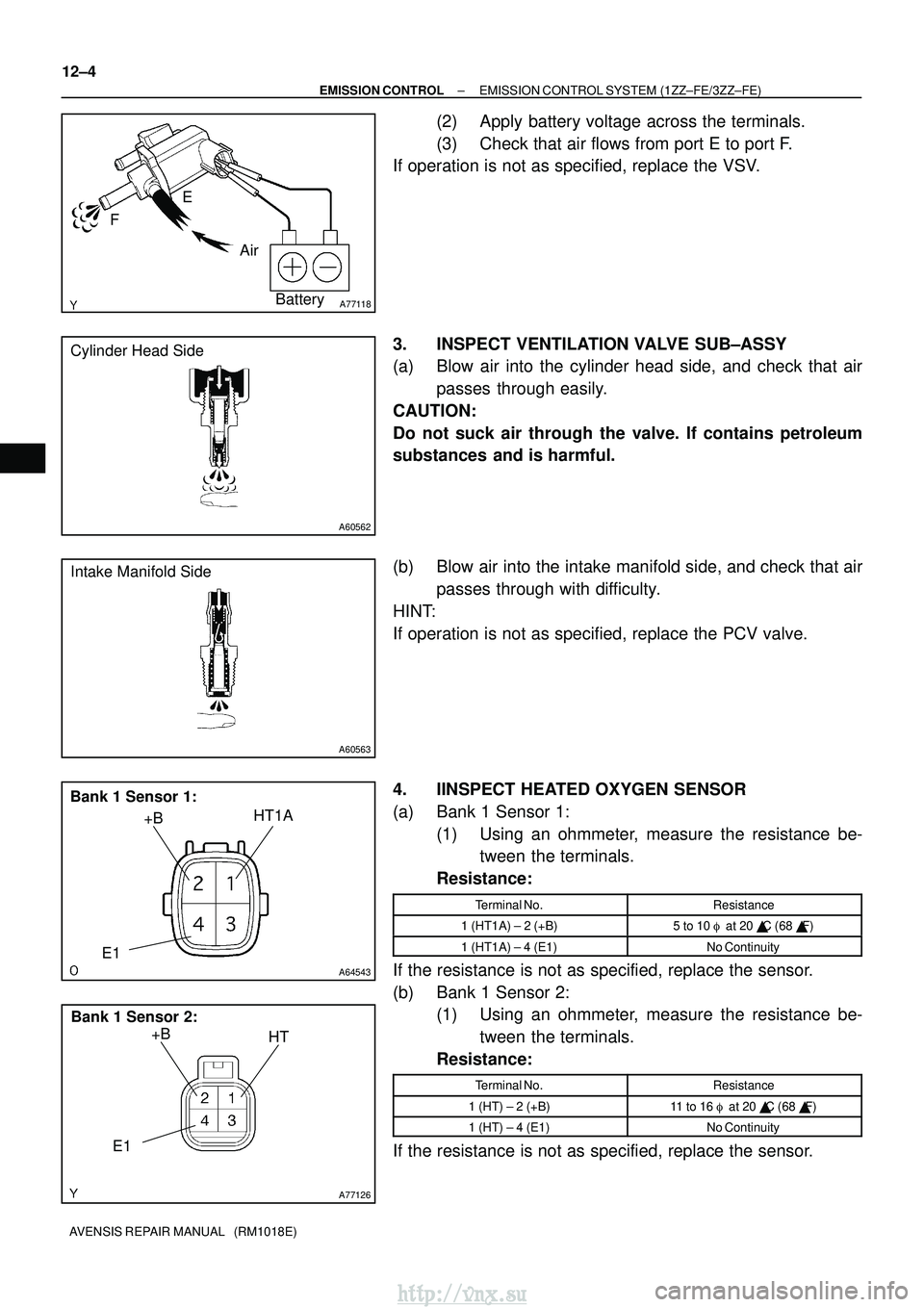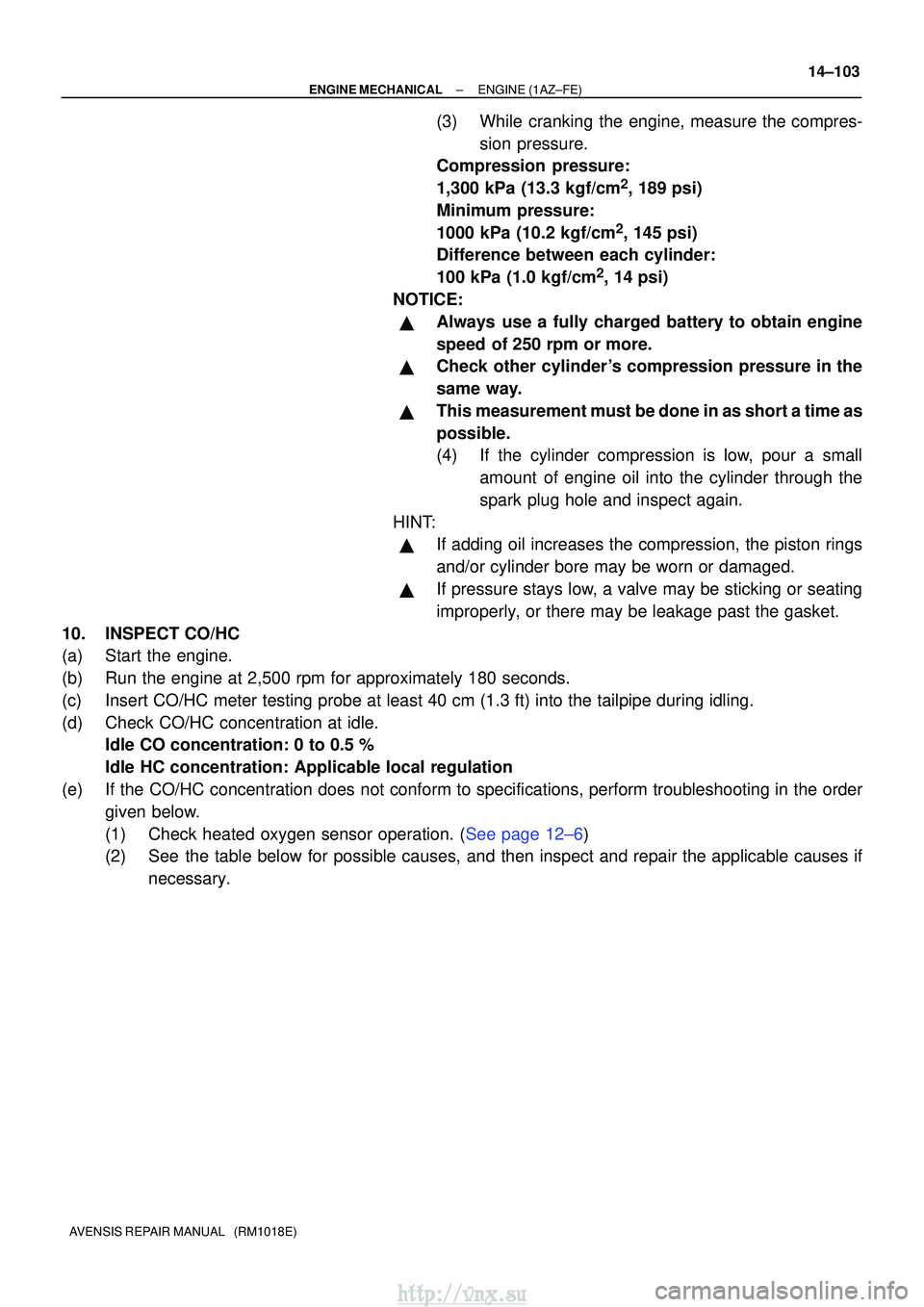Page 418 of 2234

A77115
Ohmmeter
Resistance
A77116
Ohmmeter
No continuity
A77117
Air
E
F
A77118
Air
E
F
Battery
A64543
+B
Bank 2 Sensor 1: HT
E1
12±14
±
EMISSION CONTROL EMISSION CONTROL SYSTEM (1AZ±FSE)
AVENSIS REPAIR MANUAL (RM1018E)
4. INSPECT VACUUM SWITCHING VALVE ASSY NO.1
(a) Inspect VSV for open circuit. (1) Using an ohmmeter, measure resistance between
the terminals.
Resistance: 26 to 30 � at 20 �C (68� F)
If the resistance is not as specified, replace the VSV.
(b) Inspect the VSV for ground. (1) Using an ohmmeter, check that there is no continu-
ity between each terminal and the body.
If there is continuity, replace the VSV.
(c) Inspect the VSV operation. (1) Check that air flows with a little difficulty from port Eto port F.
(2) Apply battery voltage across the terminals.
(3) Check that air flows from port E to port F.
If operation is not as specified, replace the VSV.
5. INSPECT HEATED OXYGEN SENSOR
(a) Bank 2 Sensor 1: (1) Using an ohmmeter, measure the resistance be-
tween the terminals.
Resistance:
Terminal No.Resistance
1 (HT) ± 2 (+B)11 to 16 � at 20 �C (68 �F)
1 (HT) ± 4 (E1)No Continuity
If the resistance is not as specified, replace the sensor.
http://vnx.su
Page 420 of 2234

1209G±02
A59588
E1
OX1A OX1B
OX2B
OX2A
ECM
A77114
±
EMISSION CONTROL EMISSION CONTROL SYSTEM (1AZ±FSE)
12±11
AVENSIS REPAIR MANUAL (RM1018E)
EMISSION CONTROL SYSTEM (1AZ±FSE)
ON±VEHICLE INSPECTION
1. INSPECT AIR±FUEL RATIO COMPENSATION SYS-
TEM
HINT:
You can also check the system by choosing ºDATA MONITOR/
O
2 SENSOR OUTPUT VOLTAGEº on the monitor of the hand±
held tester.
(a) Connect the hand±held tester to the following each pair of the ECM terminals:
(1) Terminals 21 (OX1B) and 1 (E1)
(2) Terminals 22 (OX1A) and 1 (E1)
(3) Terminals 23 (OX2A) and 1 (E1)
(4) Terminals 29 (OX2B) and 1 (E1)
CAUTION:
Connect test leads from the back side of the connector with
the ECU connected.
(b) Warm up the heated oxygen sensor with the engine speed at 2,500 rpm for approximately 2 minutes.
(c) Confirm that the voltage output varies between 0V to 1V with the engine speed at 2,500 rpm.
OK:
The voltage output varies more than 8 times in 10 se-
conds.
CAUTION:
�Perform the check immediately after the warming up.
�If the voltage variation could not be verified, warm up
the heated oxygen sensor again.
2. INSPECT FUEL CUT OFF RPM
(a) Increase the engine speed to at least 3,500 rpm.
(b) Use a sound scope to check for injector operating sounds.
(c) Check that the injector operating sounds stops momentarily and then resumes th\
at when the throttle lever is released. 3. INSPECT EVAPORATIVE EMISSION CONTROL SYS-TEM
(a) After starting the engine, disconnect the vacuum hose
shown in the illustration.
(b) Check if vacuum occurs at the VSV port when choosing ºACTIVE TESTº and ºPURGE VSVº according to the dis-
play on hand±held tester.
(c) Finish ºACTIVE TESTº, then reconnect the vacuum hose.
(d) After entering to ºECU DATA MONITORº on the hand±
held tester, choose ºPURGE VSVº to check the operation
of the purge VSV.
(e) After driving the vehicle with a warm engine, confirm that
the VSV turns from off on to.
http://vnx.su
Page 424 of 2234

A77118
Air
E
F
Battery
A60562
Cylinder Head Side
A60563
Intake Manifold Side
A64543
+B
Bank 1 Sensor 1: HT1A
E1
A77126
HT
+B
Bank 1 Sensor 2:
E1
12±4
±
EMISSION CONTROL EMISSION CONTROL SYSTEM (1ZZ±FE/3ZZ±FE)
AVENSIS REPAIR MANUAL (RM1018E)
(2) Apply battery voltage across the terminals.
(3) Check that air flows from port E to port F.
If operation is not as specified, replace the VSV.
3. INSPECT VENTILATION VALVE SUB±ASSY
(a) Blow air into the cylinder head side, and check that air
passes through easily.
CAUTION:
Do not suck air through the valve. If contains petroleum
substances and is harmful.
(b) Blow air into the intake manifold side, and check that air passes through with difficulty.
HINT:
If operation is not as specified, replace the PCV valve.
4. IINSPECT HEATED OXYGEN SENSOR
(a) Bank 1 Sensor 1: (1) Using an ohmmeter, measure the resistance be-tween the terminals.
Resistance:
Terminal No.Resistance
1 (HT1A) ± 2 (+B)5 to 10 � at 20 �C (68 �F)
1 (HT1A) ± 4 (E1)No Continuity
If the resistance is not as specified, replace the sensor.
(b) Bank 1 Sensor 2:
(1) Using an ohmmeter, measure the resistance be-
tween the terminals.
Resistance:
Terminal No.Resistance
1 (HT) ± 2 (+B)11 to 16 � at 20 �C (68 �F)
1 (HT) ± 4 (E1)No Continuity
If the resistance is not as specified, replace the sensor.
http://vnx.su
Page 426 of 2234

1209C±02
A65749
E1OX1AOX1B
ECM
A66059
±
EMISSION CONTROL EMISSION CONTROL SYSTEM (1ZZ±FE/3ZZ±FE)
12±1
AVENSIS REPAIR MANUAL (RM1018E)
EMISSION CONTROL SYSTEM (1ZZ±FE/3ZZ±FE)
ON±VEHICLE INSPECTION
1. INSPECT AIR±FUEL RATIO COMPENSATION SYS-
TEM
HINT:
You can also check the system by choosing ºDATA MONITOR/
O
2 SENSOR OUTPUT VOLTAGEº on the monitor of the hand±
held tester.
(a) Connect the hand±held tester to the terminals 21 (OX1B) and 7 (E1) and to terminals 23 (OX1A) and 7 (E1) of the
ECM.
CAUTION:
Connect test leads from the back side of the connector with
the ECM connected.
(b) Warm up the heated oxygen sensor with the engine speed at 2,500 rpm for approximately 2 minutes.
(c) Confirm that the voltage varies output between 0V to 1V with the engine speed at 2,500 rpm.
OK:
The voltage output varies more than 8 times in 10 se-
conds.
CAUTION:
�Perform the check immediately after the warming up.
�If the voltage variation could not be verified, warm up
the heated oxygen sensor again.
2. INSPECT FUEL CUT OFF RPM
(a) Increase the engine speed to at least 3,500 rpm.
(b) Use a sound scope to check for injector operating sounds.
(c) Check that injector operating sounds stops momentarily and then resumes when \
the throttle lever is released.
3. INSPECT EVAPORATIVE EMISSION CONTROL SYS-TEM
(a) After starting the engine, disconnect the vacuum hose
shown in the illustration.
(b) Check if vacuum occurs at the VSV port when choosing ºACTIVE TESTº and ºPURGE VSVº according to the dis-
play on hand±held tester.
(c) Finish ºACTIVE TESTº, then reconnect the vacuum.
(d) After entering to ºECU DATA MONITORº on the hand±
held tester, choose ºPURGE VSVº to check the operation
of the purge VSV.
(e) After driving the vehicle with a warm engine, confirm that
the VSV turns from off to on.
http://vnx.su
Page 547 of 2234
A56446
A52499
A52497
±
ENGINE MECHANICALCYLINDER HEAD GASKET(1AZ±FE)
14±163
AVENSIS REPAIR MANUAL (RM1018E)
45.REMOVE THROTTLE BODY ASSY (See page 10±26)
46.REMOVE INTAKE MANIFOLD
(a)Remove the 5 bolts and 2 nuts, then remove the intakemanifold and gasket.
47.REMOVE INTAKE MANIFOLD INSULATOR NO.1
48.REMOVE MANIFOLD CONVERTER INSULATOR NO.1
(a)Disconnect the oxygen sensor connector.
(b)Remove the 2 bolts and nut, and then remove the manifold heat insulator. 49.REMOVE EXHAUST MANIFOLD CONVERTERSUB±ASSY
(a)Remove the 2 bolts and 2 nuts, then detach the No. 1 and No. 2 exhaust manifold stay.
(b)Disconnect the 3 oxygen sensor connectors.
(c)Remove the 5 nuts, the exhaust manifold and gasket.
50.REMOVE NO.2 CAMSHAFT (See page 14±171)
51.REMOVE CAMSHAFT (See page 14±171)
52. REMOVE CAMSHAFT TIMING OIL CONTROL VALVE ASSY (W/ VVT±i)
(a) Remove the bolt and the oil control valve.
http://vnx.su
Page 555 of 2234
A77302
A77353
±
ENGINE MECHANICALCYLINDER HEAD GASKET(1AZ±FSE)
14±257
AVENSIS REPAIR MANUAL (RM1018E)
(e)Raise a clamp up, and slide it toward the air cleaner cap,
then remove the air cleaner cap from its case.
(f)Remove the air cleaner element.
(g)Remove the 4 bolts and the air cleaner case.
43.DISCONNECT RADIATOR HOSE INLET
44.DISCONNECT UNION TO CONNECTOR TUBE HOSE
45.DISCONNECT HEATER INLET WATER HOSE
46.SEPARATE FUEL TUBE SUB±ASSY
47.SEPARATE ENGINE WIRE
48.REMOVE THROTTLE BODY ASSY (See page 10±44)
49. REMOVE CHARCOAL CANISTER ASSY 50. REMOVE INTAKE MANIFOLD
(a) Remove the 5 bolts and 2 nuts.
(b) Disconnect the 2 vacuum hoses.
(c) Remove the 2 stud bolts.
(d) Remove the intake manifold and insulator.
51. REMOVE INTAKE AIR CONTROL VALVE ASSY
(a) Remove the intake air control valve and gasket.
52. REMOVE MANIFOLD CONVERTER INSULATOR NO.1
(a) Disconnect the oxygen sensor connector.
(b) Remove the 2 bolts and nut, and then remove the manifold insulator.
http://vnx.su
Page 556 of 2234
A77350
A52497
A32664
A56213
14±258
±
ENGINE MECHANICALCYLINDER HEAD GASKET(1AZ±FSE)
AVENSIS REPAIR MANUAL (RM1018E)
53.REMOVE EXHAUST MANIFOLD CONVERTER SUB±ASSY
(a)Remove the 2 bolts and 2 nuts, and then detach the No.
1 and No. 2 exhaust manifold stay.
(b)Disconnect the 3 oxygen sensor connectors.
(c)Remove the 5 nuts, the exhaust manifold and gasket.
54.REMOVE NO.2 CAMSHAFT (See page 14±240)
55.REMOVE CAMSHAFT (See page 14±240)
56. REMOVE CAMSHAFT TIMING OIL CONTROL VALVE ASSY
(a) Remove the bolt and the oil control valve. 57. REMOVE CAMSHAFT BEARING NO.2
58. SUPPORT ENGINE ASSEMBLY WITH TRANSAXLE
(a) Install the oil pan sub±assy.
(b) Set the jack under the engine assembly w/ transaxle, andplace a wooden block on the jack.
(c) Remove the chain block and sling devise.
http://vnx.su
Page 600 of 2234

±
ENGINE MECHANICALENGINE(1AZ±FE)
14±103
AVENSIS REPAIR MANUAL (RM1018E)
(3)While cranking the engine, measure the compres-
sion pressure.
Compression pressure:
1,300 kPa (13.3 kgf/cm
2, 189 psi)
Minimum pressure:
1000 kPa (10.2 kgf/cm
2, 145 psi)
Difference between each cylinder:
100 kPa (1.0 kgf/cm
2, 14 psi)
NOTICE:
�Always use a fully charged battery to obtain engine
speed of 250 rpm or more.
�Check other cylinder's compression pressure in the
same way.
�This measurement must be done in as short a time as
possible.
(4)If the cylinder compression is low, pour a small amount of engine oil into the cylinder through the
spark plug hole and inspect again.
HINT:
�If adding oil increases the compression, the piston rings
and/or cylinder bore may be worn or damaged.
�If pressure stays low, a valve may be sticking or seating
improperly, or there may be leakage past the gasket.
10.INSPECT CO/HC
(a)Start the engine.
(b)Run the engine at 2,500 rpm for approximately 180 seconds.
(c)Insert CO/HC meter testing probe at least 40 cm (1.3 ft) into the tail\
pipe during idling.
(d)Check CO/HC concentration at idle. Idle CO concentration: 0 to 0.5 %
Idle HC concentration: Applicable local regulation
(e)If the CO/HC concentration does not conform to specifications, perform troubleshooting in the order given below.
(1)Check heated oxygen sensor operation. (See page 12±6)
(2) See the table below for possible causes, and then inspect and repair the applicable causes ifnecessary.
http://vnx.su